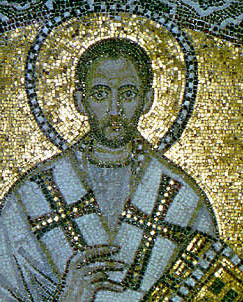| Profile | Major Works | Resources |
John Chrysostom, 347-407.

Archbishop of Constantinople and one of the leading Church Fathers in the formative years of the late 4th..
John Chrysostom was a fiery and gifted preacher, and formidable disputator, commentator and moral reformer
John, nicknamed Chrysostom ("Golden Mouth"), son of a rich army family, was trained in law and rhetoric at Antioch, under the tutelage of patriarch Meletius of Antioch. In the aftermath, John retired to monastic life, but subsequently came out of solitude and was ordained deacon at Antioch in 381, and priest in 386.
These were heady years for the fledgling Christian church in the
Roman empire. Although Christianity had been unbanned by Emperor
Constantine back in 312 and a uniform creed of Christian doctrine had
been hammered out at Council of Nicaea in 325, it was far from
universally embraced. Later Roman Emperors, keen on asserting their
power over the church, had sponsored heretical thinkers and bishops who
propounded innovations and deviations from the Nicene creed, and even
revivals of pagan religion, and drove the Nicene-adherent clergy
underground..
After the death of (Eastern) Roman Emperor Valens, a partisan of Arian
Christianity, in 378, Nicene (Catholic-Orthodox) Christian exiles began to
stream back to Constantinople. John Chrysostom emerged at this time as the
protégé of a group of orthodox theologians, known as the "Cappadocian Fathers",
which included Basil of Caesarea, Gregory of Nyssa and Gregory of Nazianzus, who
used their gifts of disputation to challenge Greek pagan philosophers, proving
that Christians can hold their own against Plato and Aristotle, and encouraging
Arian and semi-Arian bishops and others to shift their allegiance back to
Nicene Christianity. The Cappadocian fathers shined at the Synod of Antioch in 379, and cleared
the way for the all-important Council of Constantinople in 381 (the "Second
Ecumenical Council"), which restored and finalized the "Nicene Creed", the
theological formula of Catholic-Orthodox Christianity that had been first
articulated at Nicaea in 325 (but had been discarded during the Arian ascendancy
of the mid-4th C.)
John Chrysostom succeeded Nectarianus as Archbishop of Constantinople in 398.
But his rigorous moral stance proved discomforting to the powers that be
(although his denunciations of the immorality of the city's clergy and ruling
classes were immensely popular with the populace). Having offended the Eastern
empress Eudoxia, and aroused the jealousy of Archbishop Theophilus of Alexandria (who
feared Chrysostom might elevate the prominence of Constantinople above
Alexandria), a conspiracy soon evolved to depose him. At the Synod of the Oak in
403, assembled by Emperor Arcadius, John Chrysostom was accused of being in
league with the followers of Origen (a Christian theologian sympathetic to Greek
paganism), and he was deposed and banished.
Tumults in Constantinople prompted a brief recall, but he was banished again
when he renewed his diatribes against the empress. During his banishment, much
of the population of Constantinople (and many bishops and priests outside of it) refused to
recognize the successors in his seat, insisting on the restoration of John Chrysostom. The death of John Chrysostom in 407 was a relief to the imperial
authorities.
John Chrysostom's main works are a massive collection of biblical commentaries
(scriptural homilies). His treatise on the priesthood and on divine
nature are also well known. . His Adversus Judeus is notorious for
articulating the characterization of Jews as "christ-killers" and denouncing "Judaizers",
Christians who congregate in synagogues and observe Jewish rituals (like
circumcision) and holidays in order to imitate the earlier life of Christ.
|
Major Works of John Chrysostom
|
|
Resources on John Chrysostom
|
All rights reserved, Gonçalo L. Fonseca
